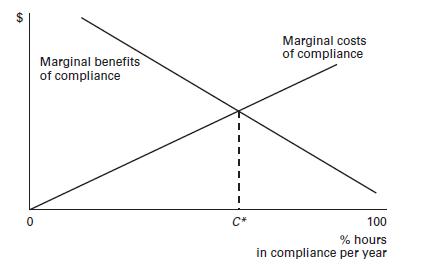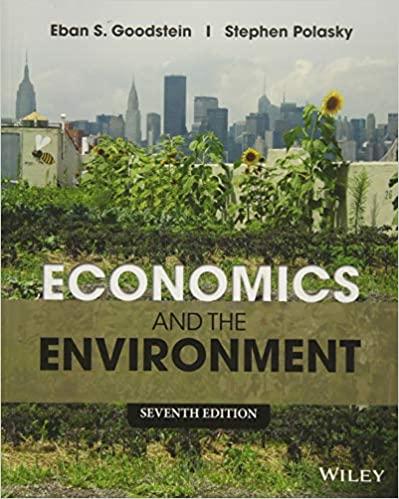Economists tend to view the decision by an individual to comply with an environmental law in terms
Question:
Economists tend to view the decision by an individual to comply with an environmental law in terms of economic motivations. While good citizenship—obeying the law simply because it is the law—certainly plays a role in affecting behavior, it is also useful to analyze compliance decisions in terms of benefits and costs.
Figure 14.3

Figure 14.3 illustrates a hypothetical marginal cost–marginal benefit analysis for a manager in a coal-fired power plant who has to decide what percentage of the time he or she plans to be in compliance with the sulfur dioxide emission standards on his or her state permit.
The benefits that come from complying with environmental laws are essentially the avoided costs of punishment: monetary costs (fines and penalties), a damaged reputation (both for corporations and individuals), and the fear of jail terms. The expected benefits depend on two factors: the magnitude of the punishment if imposed and the likelihood of getting caught and convicted. The costs of compliance, on the other hand, are simply the additional outlays needed to install, service, and maintain pollution-control equipment and complete the relevant paperwork.
1. Why are the marginal benefits of compliance high at low compliance rates?
Why are they low at high compliance rates?
2. Why are the marginal costs of compliance high at high compliance rates?
3. If C* is the economically efficient compliance rate, what are two different policy changes that would shift the marginal benefits curve to increase that rate?
4. Over one seven-year period, Weyerhaeuser—a major international paper company—racked up 122 penalized violations at its three Washington State plants, paying $721,000 in fines, bargained down from an initial $1 million. “In many cases, Weyerhaeuser continued over the years to illegally discharge the same pollutant into the same waterway . . . paying the fine with little protest.”15 Based on a model like that in Figure 14.3, would you conclude that, as it repeatedly paid fines, Weyerhauser was taking no steps to clean up its operations?
5. Here are two hard ones. The EPA officially supports a policy of setting fines to eliminate all monetary gain from noncompliance with regulations. Assume that any violation by a firm will be detected with certainty. In this case, try to figure out what theMBcurve of compliance in Figure 14.3 looks like under the EPA’s recommended policy. (The MC curve stays the same.) Will the plant manager choose full compliance?
6. In the real world, detection does not occur with certainty. In this case, will the manager choose full compliance under the EPA policy?
Step by Step Answer:

Economics And The Environment
ISBN: 9781118539729
7th Edition
Authors: Eban S. Goodstein, Stephen Polasky





